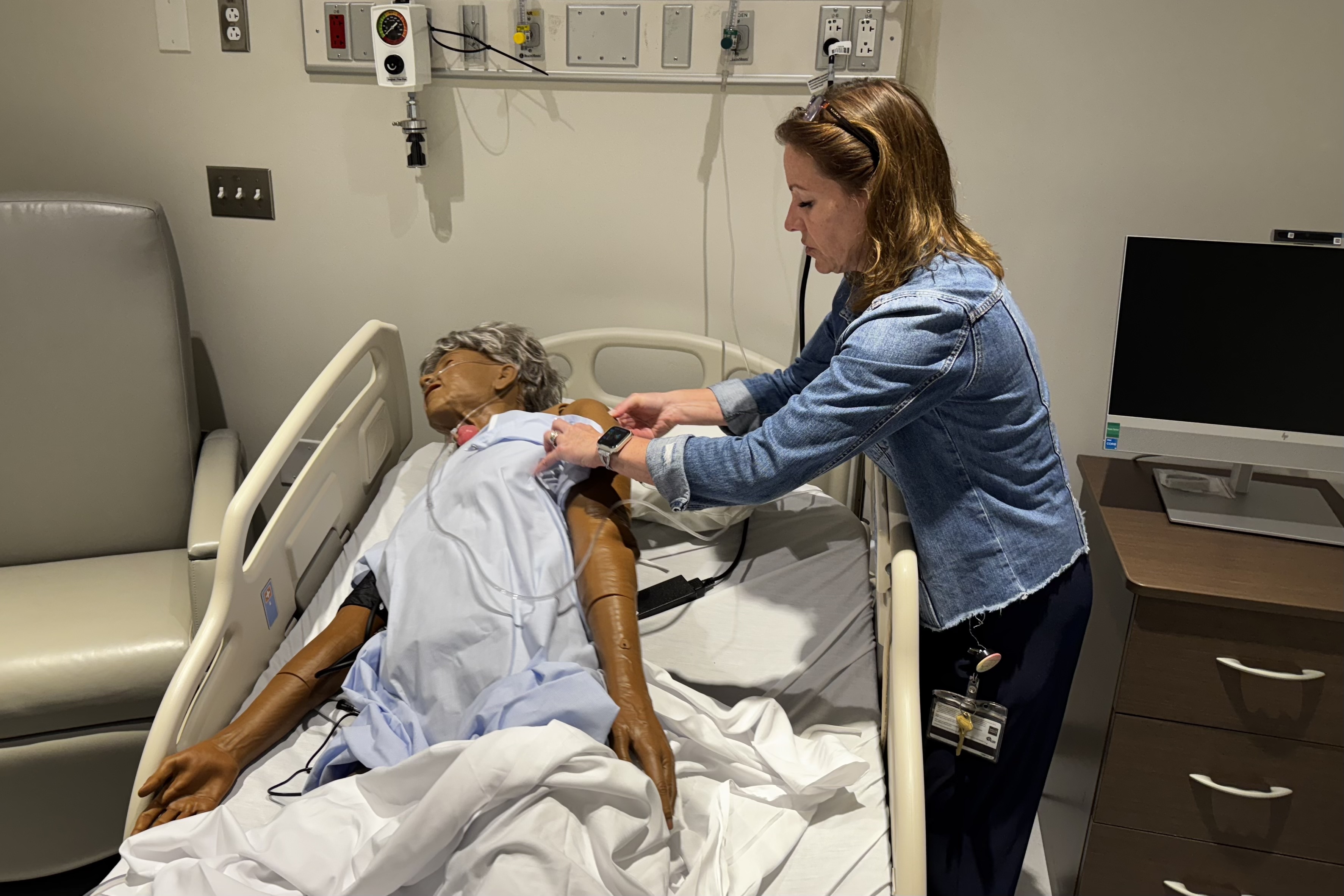CHP simulation lab upgrades raise the bar for OT and PT training
When they step into the simulation lab on the second floor of the College of Health Professions this fall, students will find it has undergone considerable changes. Thanks to a $108,000 allocation from the Higher Education Equipment Trust Fund, it now features a more immersive, hands-on training environment that reflects the evolving demands of modern health care.
The simulation lab, open to all CHP students, is fully integrated into the occupational therapy curriculum. It is anchored by four hospital-style rooms equipped to replicate clinical environments ranging from inpatient rehab to skilled nursing. Recent enhancements include computer monitors displaying different patient needs in each room, communication boards, equipment sound effects and a state-of-the-art mannequin.
“The simulation lab used to be a more basic space,” said Kerry Mader, OTD, OTR/L, CLA, c/NDT, assistant professor in the Department of Occupational Therapy. “It was still incredible, but we recognized what else students wanted and needed to succeed. As more faculty embraced simulation learning, we knew we wanted to elevate what we were providing.”

The mannequin is the centerpiece of the upgrades. It’s lifelike in more ways than one, and in addition to being high tech, it’s able to simulate a wide range of patient conditions. Weighing about 170 pounds, it includes fully movable joints, realistic skin texture and even variable pupil dilations. It can be catheterized, display different stages of tracheal healing and simulate various neurological conditions such as nystagmus, or rapid, uncontrollable eye movements. It also connects to monitors that simulate vitals such as oxygen flow and cardiac output, complete with authentic auditory cues.
“This mannequin allows students to experience what it’s like to work with someone who is medically complex, such as a patient in a medically induced coma,” Mader said. “It gives them a more authentic understanding of what it means when a patient can’t participate in moving. Someone that needs 100% assistance – this mannequin can replicate that for students.”
Each hospital-style room is wired with cameras and microphones, allowing instructors to monitor and record sessions from a central control room. Faculty can simulate different patient scenarios simultaneously, offering students a wide spectrum of clinical experiences in a single session.
“We’ll introduce the students to the simulation lab just to get comfortable with the space,” Mader said. “So it’s low stakes: sit in the bed, work the controls, get an appreciation for what your client might be going through. Then we’ll start layering clinical skills, and by midterm, they’re implementing full interventions based on case studies.”
As students advance, they will encounter more neurologically complex cases involving cognitive and motor impairments. They will also rotate roles – sometimes acting as the clinician, sometimes the patient – and be guided through sessions involving standardized patients, near-peer graduate students, or the new mannequin.
Following each session, students will gather in a dedicated debriefing room to reflect on their performance. Faculty will use live video and recorded footage to prompt discussion around decision-making, empathy, and clinical reasoning. Standardized patients, or third-year graduate students acting as patients, will participate in these conversations as well.
“Students have shared how they appreciate feedback from a near-peer, knowing they were in their shoes just a short time ago,” Mader said. “It supports encouragement, growth and confidence.”
A new documentation room provides yet another layer of realism, mimicking a common nursing workroom. Here, students will learn to transition directly from patient interaction to documentation, just as they would in a clinical setting.
“It’s a very holistic experience,” Mader said. “From introduction to closing the session, and the handoff, we’re able to guide students through the full patient care workflow.”
To help students take ownership of the space, Mader and her colleagues are hosting a naming contest for the new mannequin. OT and PT students are invited to vote on a gender-neutral name from a curated list, adding a sense of camaraderie and fun to the learning experience.
Ultimately, the upgrades are about preparing students not just to pass assessments but to thrive in high-pressure health care environments.
“This gives us the opportunity to simulate, even from an auditory standpoint, what’s going on,” Mader said. “It makes us a competitive program within the country. We now have the technology to support a higher level of application and more medically complex real-world practice.”
by John Battiston